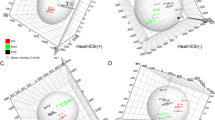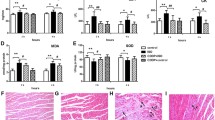Abstract
Objective
To quantify the purine concentrations of the acupoints along the pericardium and nonpericardium meridians under healthy and myocardial ischemia conditions to investigate the relationship between acupoint purine change and body functional status in rats.
Methods
A total of 70 rats underwent an operation for myocardial ischemia, while 40 of them survived. They were randomly assigned to the following 5 subgroups: Neiguan (PC 6), Quze (PC 3), Tianquan (PC 2), Quchi (LI 11), and Jianyu (LI 15). Simultaneously, another 40 healthy rats were also randomized into the same 5 subgroups as the control group. The tissue fluids at the acupoints were collected by microdialysis for 30 min. Subsequently, the concentration of adenosine triphosphate (ATP), adenosine diphosphate (ADP), adenosine monophosphate (AMP), and adenosine (ADO) were quantified using the high-performance liquid chromatography method.
Results
Compared with the healthy group, the ADO at PC 6 (P=0.012), PC 3 (P=0.038), PC 2 (P=0.024), and LI 15 (P=0.042) obviously increased in the model group, while no significant difference was observed at LI 11 (P=0.201). However, ATP, ADP, and AMP manifested no significant changes in these areas, except for ATP at LI 15 (P=0.036).
Conclusions
Myocardial ischemia could induce an increase in ADO at acupoints of the upper arm and shoulder area, suggesting that the body functional status could affect the responsiveness of acupoints. The status of these acupoints could be pathogenically activated by disease, and distribution following some specific courses.
Similar content being viewed by others
References
Chen RX, Kang MF, Chen MR. Return of Qibo: on hypothesis of sensitization state of acupoints. Chin Acupunct Moxibust (Chin) 2011;31:134–138.
Zhu B. The plasticity of acupoint. Chin Acupunct Moxibust (Chin) 2015;35:1203–1208.
Chen RX, Xie DY. Discussion on acupoint sensitization theory. J Anhui Univ Chinese Med (Chin) 2016;35:50–51.
Cheng B, Shi H, Ji CF, Li J, Chen S, Jing X. Distribution of the activated acupoints after acute gastric mucosal injury in the rat. Acupunct Res (Chin) 2010;35:193–197.
Zhu B, ed. Systematic acupuncture: renaissance of surface medicine. Beijing: People’s Medical Publishing House;2015:109–112.
Goldman N, Chen M, Fujita T, Xu Q, Peng W, Liu W, et al. Adenosine A1 receptors mediate local anti–nociceptive effects of acupuncture. Nat Neurosci 2010;13:883–888.
Takano T, Chen X, Luo F, Fujita T, Ren Z, Goldman N, et al. Traditional acupuncture triggers a local increase in adenosine in human subjects. J Pain 2012;13:1215–1223.
Gao YH, Li CW, Wang JY, Tan LH, Duanmu CL, Jing XH, et al. Effect of electroacupuncture on the cervicospinal P2X7 receptor/fractalkine/CX3CR1 signaling pathway in a rat neckincision pain model. Purinergic Signal 2017;13:215–225.
Hu L, Wang L, Wei J, Ryszard G, Shen X, Wolfgang S. Heat induces adenosine triphosphate release from mast cells in vitro: a putative mechanism for moxibustion. J Tradit Chin Med 2015;35:323–328.
Wang L, Hu L, Grygorczyk R, Shen X, Schwarz W. Modulation of extracellular ATP content of mast cells and DRG neurons by irradiation: studies on underlying mechanism of low–levellaser therapy. Mediators Inflamm 2015;2015:630361.
Yao W, Yang H, Yin N, Ding G. Mast cell–nerve cell interaction at acupoint: modeling mechanotransduction pathway induced by acupuncture. Int J Biol Sci 2014;10:511–519.
Fu SP, He SY, Xu B, Hu CJ, Lu SF, Shen WX, et al. Acupuncture promotes angiogenesis after myocardial ischemia through H3K9 acetylation regulation at VEGF gene. PLoS One 2014;9:e94604.
Yu SG, Guo Y, eds. Experimental acupuncture. Shanghai: Shanghai Science and Technology Publishing House;2009:150–152.
Shen XY, Ding GH, Deng HP, Wei JZ, Zhao L, Zhou Y, et al. Analysis on pathological information of infrared radiation spectrums at acupuncture point Neiguan (PC 6) for patients with coronary heart disease. J Infrared Millimeter Waves (Chin) 2006;25:443–446.
Zhang WB, Tian YY, Zhu ZX, Xu RM. The distribution of transcutaneous CO2 emission and correlation with the points along the pericardium meridian. J Acupunct Merid Stud 2009;2:197–201.
Xiu CY, Dong YQ, Zhu XX, Xu JS. Effects of electroacupuncturing points of pericardium meridian on hemodynamic parameters of volunteers with acute hypoxia. J Fujian Coll Tradit Chin Med (Chin) 2014;24:6–8.
Jou NT, Ma SX. Responses of nitric oxide–CGMP release in acupuncture point to electroacupuncture in human skin in vivo using dermal microdialysis. Microcirculation 2009;16:434–443.
Ma SX, Mayer E, Lee P, Li XY, Gao EZ. Transcutaneous electrical stimulation increased nitric oxide–cyclic GMP release biocaptured over skin surface of pericardium meridian and acupuncture points in humans. Acupunct Electrother Res 2015;40:73–86.
Ma SX, Li XY, Smith BT, Jou NT. Changes in nitric oxide, cGMP, and nitrotyrosine concentrations over skin along the meridians in obese subjects. Obesity 2011;19:1560–1567.
Ma SX. Nitric oxide signaling molecules in acupoints: toward mechanisms of acupuncture. Chin J Integr Med 2017;23:812–815.
Tang Y, Yin HY, Rubini P, Illes P. Acupuncture–induced analgesia: a neurobiological basis in purinergic signaling. Neuroscientist 2016;22:563–578.
Huang YH, Weng XH, Zhou ZQ. Extracellular ATP: effects, sources and fate. Progr Pysiol Sci (Chin) 1998;29:115–119.
He W, Wu M, Jing XH, Bai WZ, Zhu B, Yu XC. Entity of acupoint: kinetic changes of acupoints in histocytochemistry. Acupunct Res (Chin) 2015;35:1181–1186.
Li P, Pitsillides KF, Rendig SV, Pan HL, Longhurst JC. Reversal of reflex–induced myocardial ischemia by median nerve stimulation: a feline model of electroacupuncture. Circulation 1998;97:1186–1194.
Liu Q, Yang L, Li ZH. Projection and con–origin of the rat heart and point Neiguan nerve, and the neural transmitter property of the con–origin neurons. Acta Acad Med Shandong (Chin) 2004;42:99–102.
Liu JL, Chen SP, Gao YH. Role of the spinal cord in the improvement of performance of ischemic heart induced by electroacupuncture of "Neiguan"(PC 6)–"Jianshi"(PC 5). Acupuncture Res (Chin) 2005;30:155–158.
Liu X, Zhang Q, Han M, Du J. Intrapericardial capsaicin and bradykinin induce different cardiac–somatic and cardiovascular reflexes in rats. Auton Neurosci 2016;198:28–32.
Han M, Liu X, Du J. Modulatory effect of neurokinin–1 and non–N–methyl–D–aspartate receptors on cardiosomatic reflex in rat spinal cord. J Southern Med Univ (Chin) 2014;34:1728–1732.
Goldman N, Chandler–Militello D, Langevin HM, Nedergaard M, Takano T. Purine receptor mediated actin cytoskeleton remodeling of human fibroblasts. Cell Calcium 2013;53:297–301.
Nagaoka S, Shinbara H, Okubo M, Kawakita T, Hino K, Sumiya E. Contributions of ADP and ATP to the increase in skeletal muscle blood flow after manual acupuncture stimulation in rats. Acupunct Med 2016;34:229–234.
Acknowledgement
We are grateful to all the participants and staffs in the trial.
Author information
Authors and Affiliations
Corresponding author
Additional information
Supported by National Natural Science Foundation of China (No. 81590951, 81373559, 81373561 and 81573885), the State Key Program for Basic Research of China (No. 2012CB518501), and the Project of the Second Clinical Medical College of Nanjing University of Chinese Medicine (No. RLZZ201605)
Rights and permissions
About this article
Cite this article
Zhou, Ym., Zhuang, Y., Cai, Dj. et al. Purines Change at Acupoints along the Pericardium Meridian in Healthy and Myocardial Ischemic Rats. Chin. J. Integr. Med. 25, 285–291 (2019). https://doi.org/10.1007/s11655-018-2932-8
Received:
Published:
Issue Date:
DOI: https://doi.org/10.1007/s11655-018-2932-8




